How to start 4-play services and lose money on it: MGTS example

/ photo Al_HikesAZ
Recently, in the telecom sector, the news was actively circulating that MGTS would make mobile communication free for its subscribers - for this they would need to connect the “fast” wired Internet tariff.
')
We have already written about the likelihood of creating a truly free connection (spoiler: not in the coming years), so let's talk about package tariffs (“bundles”) and their use to increase profits.
What are bundles?
We have written a lot about the packaging of carrier services in a blog , briefly highlighting the main points. Bundles can be hard and soft:
- hard , which include services with specific parameters (for example, the Internet 20 Mbit / s + 50 TV channels for 600 rubles per month);
- soft , allowing subscribers to independently assemble a package from the available offers separately, after which, based on the type and number of selected services, billing automatically calculates a discount.
Hard packages are well suited for launching converged telecom products to the market, when a new service is “forcibly” added to a well-known old one. The logic is simple - subscribers do not know the new service, and therefore they are unlikely to want to buy separately. But if you sell it with the “train” for a popular old service and with a good discount, then you can raise sales of the old service and promote the new one. There should be a limited number of such package offers to make it easier for customers to choose.
When subscribers have become accustomed to the new service of the operator and become sophisticated, you can offer them soft bundles for self-assembly of individual tariffs.
It is along this path that MGTS went, and everything would be fine, but the implementation of a good idea raises questions.
Problem of choice
The choice is good, the main thing is not to overdo it. But it is precisely in this situation that MGTS subscribers find themselves on the page of the operator ’s package tariffs . They are offered to independently choose a ready-made set of four services in 48 (!) Different combinations: 24 tariffs with a home phone and 24 more without it. “You need to earn a discount” - as MGTS tells us.
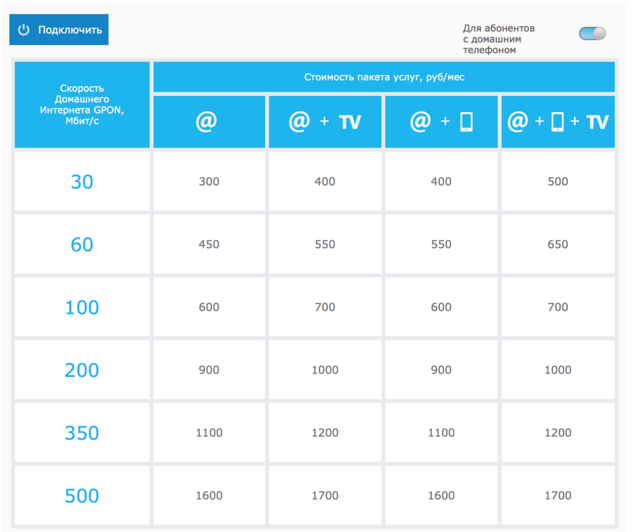
It is worth noting that MGTS actually has even more tariff plans, since each service can be purchased separately, each also has several tariff plans, and some of them are with additional options, for example, digital TV. But the site is designed so that even we didn’t manage to understand them right away.
The overwhelming majority of subscribers are unlikely to master the task of choosing from several dozen tariff plans scattered across different sections of the site — people simply have no time to engage in such analysis.
In addition, MGTS packages include only the simplest tariffs for mobile communications and TV. What to do if the subscriber wants something more expensive? In the current implementation, the operator simply receives less money.
After criticizing a similar approach expressed in a profile telecom group on Facebook, MGTS made changes to the design of the tariff page. Attempting to rectify the situation by transposing the matrix turned out to be not very successful - the fate of users did not become easier.
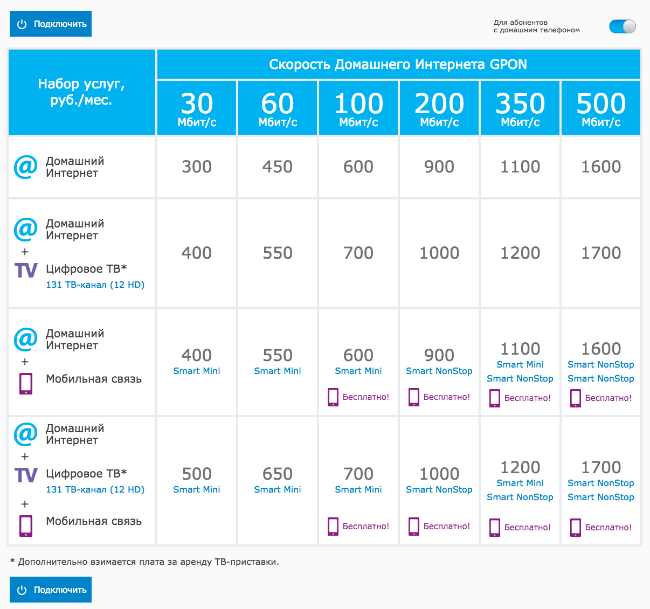
MGTS can sympathize - from a large number of services is difficult to make a small number of fixed packages, while not scaring the audience. Nevertheless, this task could be much more elegant.
So, the American operator AT & T, which offers the same four services as MGTS, has a wizard for creating a dial-up tariff on its website - the user can add new services to the package and see not only how the price changes, but also how the discount grows when ordering more and more services:
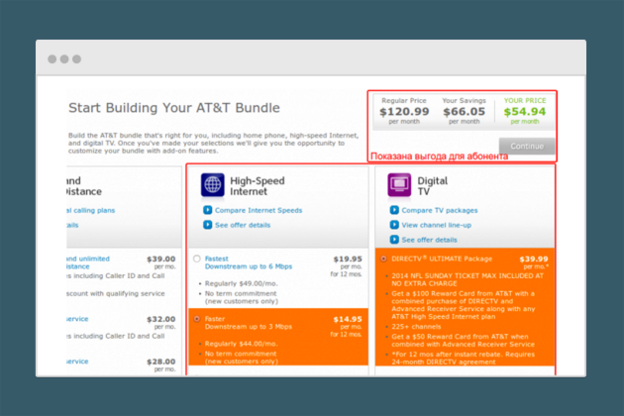
In this case, everything is simple and clear - you choose the parameters and see the discount. And for those who do not have time to think, the master begins with the proposal to choose one of a small number of running (and most beneficial for the operator) pre-installed packages.
The problem is that behind the tip of the iceberg of apparent simplicity lies a large-scale infrastructure. In particular, the billing system, which should support soft packet tariffs.
Why not do well
Surely, both MGTS and other operators, who offer their subscribers a choice of a large number of options, treat their customers well. However, this is not enough - you also need the technical ability to make the choice convenient.
Usually in such situations, the operator rests on the billing system, which at best allows you to create only fixed packages, like MGTS. To make a discount calculator like AT & T, billing must know the rules for applying these discounts.
The result is that the operator has made great efforts to give subscribers a new service, but is forced to make compromises and lose money because of such a banal (in any case, for us) flaws.
You can solve the problem with the help of billing, which supports both types of package tariffs - such as Hydra . Here's how it could be used to implement MGTS package offers:

From the tariff table it is clear that the initial idea of marketers was simple and clear to any subscriber:
- There is a basic line of six Internet access rates at different speeds (the first column of the table).
- Digital TV adds 100 rubles to any base rate.
- Mobile communication adds another 100 rubles to the two junior base rates, and for the four older ones it is free.
The only question is the technical implementation of this idea. Here's how to do this in Hydra with two simple rules. The first is for lower basic tariff plans for the Internet (30 and 60 Mbit / s): the services of mobile communication and TV ordered with them add to the price of 100 rubles each:
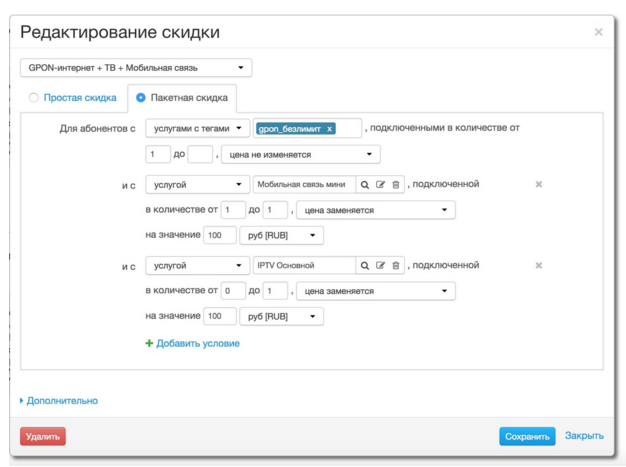
The second is for expensive tariffs: TV still adds 100 rubles to them, and mobile communication is attached for free:
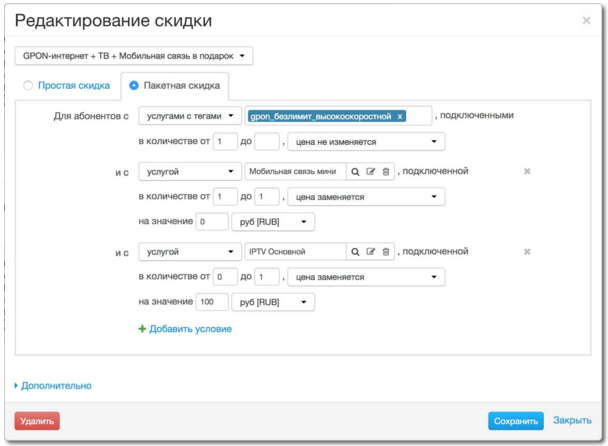
If, in accordance with these rules and basic tariffs for each MGTS service, to make a discount calculator on the site, then it will allow:
- Get rid of the "sheets" with the package offers.
- Summarize the separate quotes for each service into a single connection master.
- To give customers the opportunity to collect a package not only from basic tariff plans, but also from more expensive ones, along with adding paid options to them.
- Offer lazy customers a few ready (most profitable) packages.
- On several millions of subscribers, these measures will have an effect that will be expressed in tens of millions of rubles a year.
Conclusion
According to our estimates, a flexible tariff policy, coupled with well-designed service packages, can increase ARPU by 15–30% for an existing subscriber base. The operator not only earns more, but also gives subscribers pleasant emotions - the opportunity to choose gives people a sense of freedom and control; they think they can save, if they themselves choose only what they need. At the same time, often even taking into account discounts, packages and tariff options increase the price of the base tariff by 50–100%.
When competition is growing, the telecom company should not neglect the possibility of additional earnings. Unfortunately, even the best initiatives sometimes face a harsh reality in the form of limited billing capabilities.
If you do not give subscribers the level of convenience they are used to working with other companies, from taxis to banks, they will vote with their feet, and the modern, technically complex service, in which big money is invested, will remain unclaimed. If you choose the tools that were originally created to help marketing, the return will be noticeable and not take long to wait.
Other articles on IT infrastructure from the Latera team:
- Weekdays billing: How we prepared for the denomination in Belarus
- How to make migration to a new billing easy and understandable: automate data transfer
- We automate the accounting of addresses and bindings in IPoE-networks
- Developing an application to increase the efficiency of field staff: Experience Planado.ru
- What else affects the infrastructure: How to ensure the quality of equipment installation
Source: https://habr.com/ru/post/311526/
All Articles